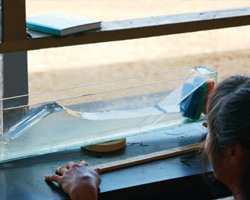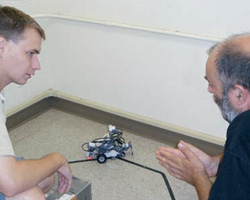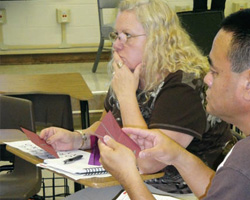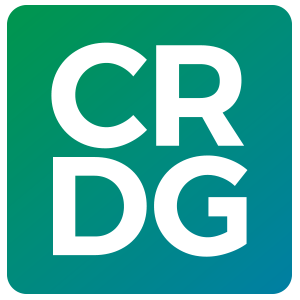
11 Jan NSF Program Brings Graduate Students into Hawai‘i Schools

Teachers study the behavior of waves as part of a marine science educators’ workshop.
CRDG’s 10-year partnership with the University of Hawai’i’s interdisciplinary Ecology, Evolution, and Conservation Biology (EECB) program in the National Science Foundation’s Graduate Teaching Fellows in K–12 Education (GK–12) program came to an end this year just as CRDG’s Linda Venenciano began work on another GK–12 collaboration, this one with UH Mānoa’s Department of Mathematics.
The GK–12 program is designed to create partnerships among graduate students in science and mathematics and classroom teachers and their students. The partnerships serve to bring original research into K–12 environments in engaging and meaningful ways while providing the fellows with valuable teaching experience. Among NSF’s primary goals is that fellows learn how to communicate their research to the general public and connect to a lifetime of service to education. Graduate fellows and classroom teachers in the Hawai’i public school system are partnered to engage in a unique collaborative experience that allows students to see and experience research first-hand. In both of these projects, CRDG brought its expertise in education and its experience working directly with K–12 schools to the partnership.
 The collaboration with the Ecology, Evolution, and Conservation Biology program has left a legacy that promises continuing interaction between fellows and K–12 schools. The OPIHI (Our project in Hawai’i’s intertidal) project, initiated by a GK–12 fellow working with the ninth grade class at ULS, is now in its seventh year as one of the few ongoing conservation and monitoring efforts in Hawai’i’s intertidal zone, and it continues to grow and expand. The EECB GK–12 faculty and fellows also produced two articles this year that highlight the many innovative ways the fellows were able to bring cutting-edge science into classrooms. CRDG’s Kanesa Duncan and GK–12 fellow Kimberly Tice, who went on to become a marine science educator at the brand new Center for Microbial Oceanography: Research and Education (C-MORE) at UHM and is now a biologist with the National Park Service at Kalaupapa on Moloka’i, published “The Case of the Sick Coral,” a series of inquiry lessons that guide high school students in developing and testing hypotheses about the susceptibility of corals to bleaching, in Current, The Journal of Marine Education. The second publication, “Sorting out Sediment Grain Size in Sand,” which presents a series of three lessons on density, published in Oceanography, was a collaboration between Duncan, GK–12 fellow Heather Spalding, and UH Sea Grant coastal geologist Zoe Norcross-Nu’u.
The collaboration with the Ecology, Evolution, and Conservation Biology program has left a legacy that promises continuing interaction between fellows and K–12 schools. The OPIHI (Our project in Hawai’i’s intertidal) project, initiated by a GK–12 fellow working with the ninth grade class at ULS, is now in its seventh year as one of the few ongoing conservation and monitoring efforts in Hawai’i’s intertidal zone, and it continues to grow and expand. The EECB GK–12 faculty and fellows also produced two articles this year that highlight the many innovative ways the fellows were able to bring cutting-edge science into classrooms. CRDG’s Kanesa Duncan and GK–12 fellow Kimberly Tice, who went on to become a marine science educator at the brand new Center for Microbial Oceanography: Research and Education (C-MORE) at UHM and is now a biologist with the National Park Service at Kalaupapa on Moloka’i, published “The Case of the Sick Coral,” a series of inquiry lessons that guide high school students in developing and testing hypotheses about the susceptibility of corals to bleaching, in Current, The Journal of Marine Education. The second publication, “Sorting out Sediment Grain Size in Sand,” which presents a series of three lessons on density, published in Oceanography, was a collaboration between Duncan, GK–12 fellow Heather Spalding, and UH Sea Grant coastal geologist Zoe Norcross-Nu’u.

Teachers in the SUPER-M GK–12 program work with fellows to bring current research in mathematics into their classroom
The newly funded, five-year, GK–12 project in the UH Mānoa Department of Mathematics, known as School and University Partnership for Educational Renewal in Mathematics (SUPER-M), began in 2009 with six fellows working on three islands in schools that include elementary, middle, and high schools and public as well as Hawaiian culture-based charter schools. CRDG’s Linda Venenciano brings her background as a classroom teacher, curriculum developer, and longtime teacher trainer to the project and serves as a bridge between the university and the K–12 schools in her role as program manager. The project’s objectives include contributing to the formation of highly qualified teachers; providing students, especially in under-represented groups, with an enriching learning environment where mathematics is interesting and dynamic and that provides a solid grounding in mathematics, thereby increasing their opportunities to pursue careers in STEM disciplines; and providing fellows with a better understanding of the K–12 education system and how they can positively impact it.




